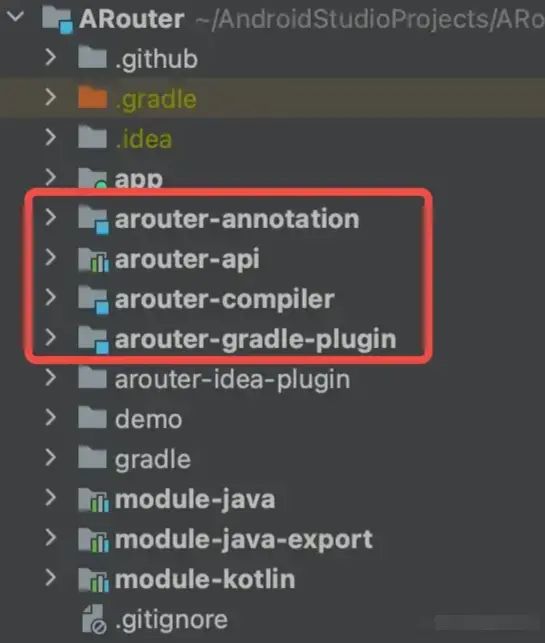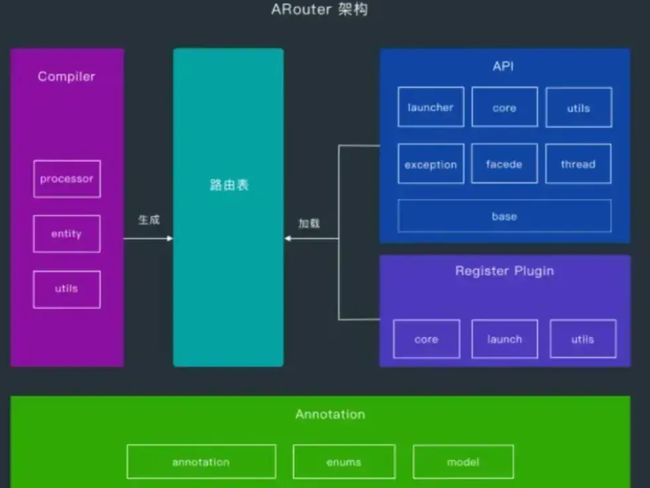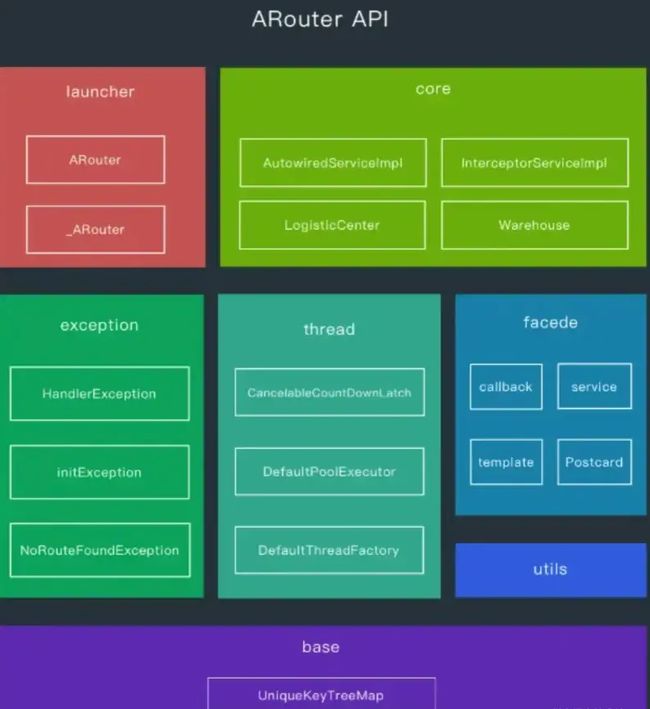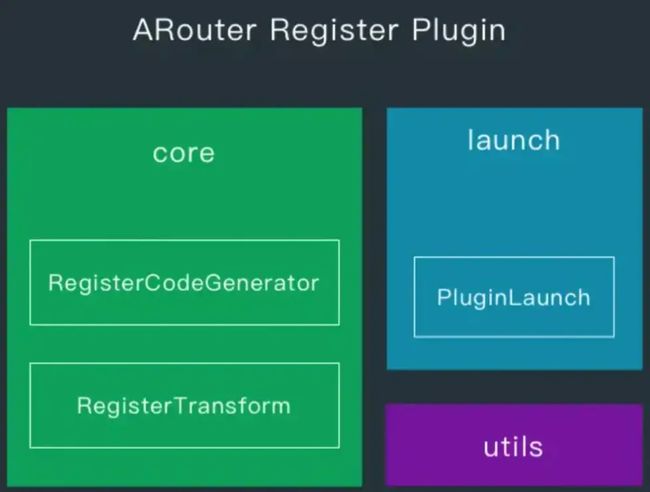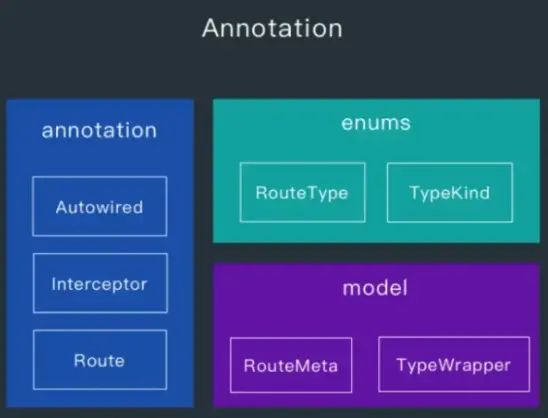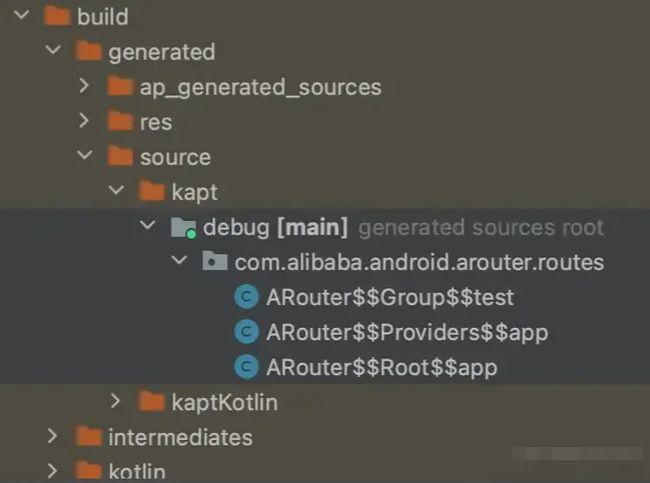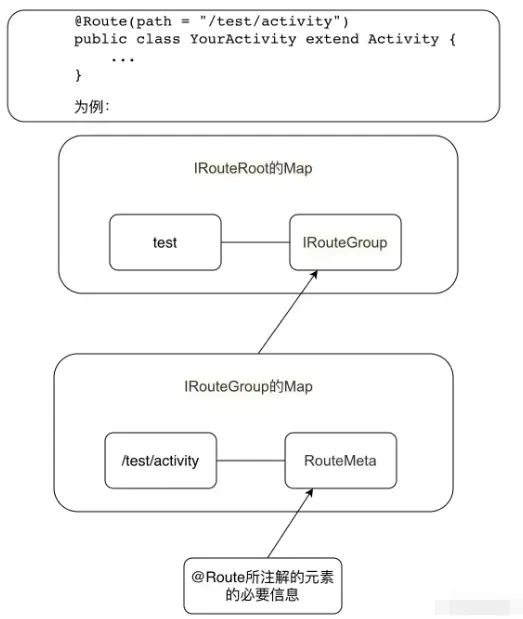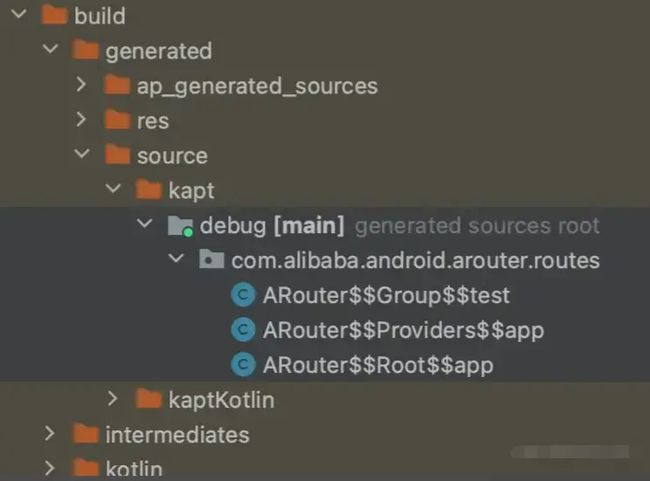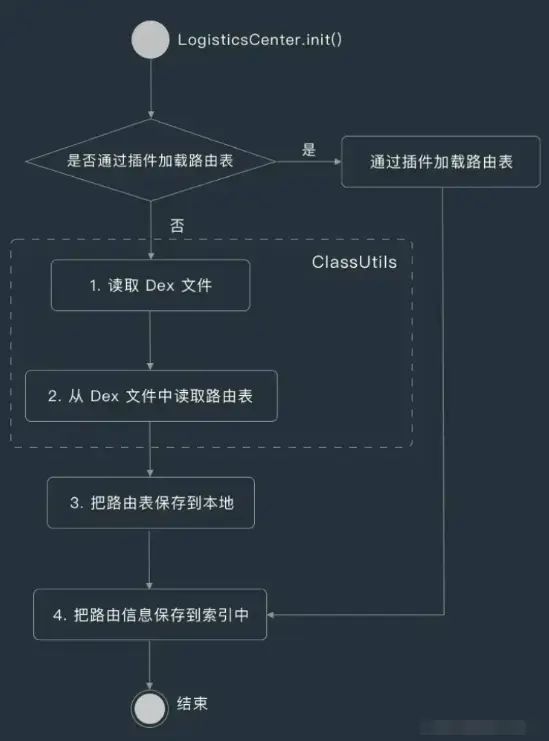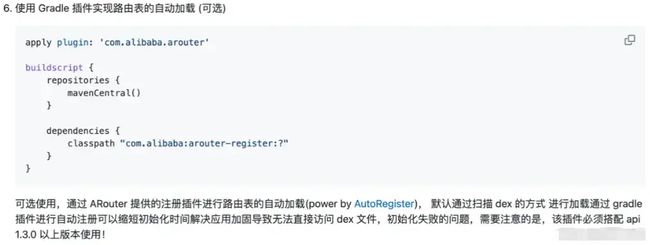ARouter基本使用及原理分析
作者:愿天深海
ARouter简介
ARouter是阿里开源的一款帮助Android App进行组件化改造的路由框架,是Android平台中对页面和服务提供路由功能的中间件,可以实现在不同模块的Activity之间跳转。
ARouter的特点是灵活性强还能帮助项目解耦。
除了广为人知的Activity跳转之外,ARouter还支持获取Fragment,解耦服务使得跨模块API调用等等
ARouter原理概述
ARouter使用@Route注解,在编译时期通过APT技术生成类文件用于存储path和activityClass的映射关系。
在app进程启动的时候会拿到这些类文件,把里面存储的映射关系数据读到内存里,保存在路由表map中。 在进行路由跳转时,通过ARouter的build()方法传入要到达页面的路由地址,ARouter在路由表中找到路由地址对应的activityClass,然后new Intent(),通过ARouter的withString()方法传入携带参数,内部调用intent.putExtra(),通过ARouter的navigation()跳转,内部调用startActivity(intent)。
这样就实现了在不同模块之间,不相互依赖,却顺利启动对方的Activity。
ARouter基本用法
添加依赖与配置
//注解处理插件
plugins {
...
id 'kotlin-kapt'
}
//注解处理选项
kapt {
arguments {
arg("AROUTER_MODULE_NAME", project.getName())
}
}
//依赖
dependencies {
// 替换成最新版本, 需要注意的是api要与compiler匹配使用,均使用最新版可以保证兼容
implementation 'com.alibaba:arouter-api:x.x.x'
kapt 'com.alibaba:arouter-compiler:x.x.x'
...
}
添加注解
// 在支持路由的页面上添加注解(必选)
// 这里的路径需要注意的是至少需要有两级,/xx/xx
@Route(path = "/test/activity")
public class YourActivity extend Activity {
...
}
初始化SDK
if (isDebug()) { // 这两行必须写在init之前,否则这些配置在init过程中将无效
ARouter.openLog(); // 打印日志
ARouter.openDebug(); // 开启调试模式(如果在InstantRun模式下运行,必须开启调试模式!线上版本需要关闭,否则有安全风险)
}
ARouter.init(mApplication); // 尽可能早,推荐在Application中初始化
发起路由操作
// 1. 应用内简单的跳转(通过URL跳转在'进阶用法'中)
ARouter.getInstance().build("/test/activity").navigation();
// 2. 跳转并携带参数
ARouter.getInstance().build("/test/1")
.withLong("key1", 666L)
.withString("key3", "888")
.withObject("key4", new Test("Jack", "Rose"))
.navigation();
ARouter架构概览
ARouter项目代码结构如上,红框内为最核心的4部分,架构关系如下,
ARouter项目中包含了API、编译器Compiler、插件Gradle Plugin和注解Annotation4 个模块。
API
API 模块由launcher、core、exception、thread、facede、utils和base子模块组成。
- launcher:包含了启动器 ARouter。
- core:包含物流中心 LogsticsCenter 和仓库 Warehouse 等类。
- exception:包含了一些异常类。
- thread:包含了CancellableCountDownLatch,ARouter 的拦截器链是放在子线程中执行的,就用到了它。
- facede:包含了导航回调 NavigationCallback 和 拦截器IInterceptor 等接口。
- utils:包含了 ARouter 自定义的日志打印器等工具类。
- base:只有一个用于保存拦截器的 UnitqueKeyTreeMap。
Compiler
Compiler 模块用于生成路由表,@Autowired、@Interceptor 和 @Route 注解对应的注解处理器分别是 AutowiredProcessor、InterceptorProcessor 以及 RouteProcessor ,都在 Compiler 中。
Register Plugin
Register Plugin 模块包含了注册代码生成器 RegisterCodeGenerator 和 RegisterTransform,如果使用了ARouter的路由表加载插件,那这个路由表就会由Register插件加载。
Annotaion
Annotaion模块比较简单,只包含了一些注解和枚举类。
APT原理
ARouter的使用非常方便,得益于APT技术。APT的作用是在编译阶段扫描并处理代码中的注解,然后根据注解输出Java文件。
ARouter为了方便实现注解处理器还额外用了两个库。
- JavaPoet,提供了调用对象方法的方式生成需要的代码,而不再需要人为地用StringBuilder去拼接代码,再使用IO写入文件。
- Auto-Service,提供了简便的方式去注册APT,避免了原本繁琐的注册步骤。
@Route
@Route的定义:
@Target({ElementType.TYPE})
@Retention(RetentionPolicy.CLASS)
public @interface Route {
/**
* Path of route
*/
String path();
......
}
- @Target({ElementType.TYPE}):表示这个注解是修饰类的
- @Retention(RetentionPolicy.CLASS):表示需要保留到编译时
使用该注解时有一个主要的参数path:
// 在支持路由的页面上添加注解(必选)
// 这里的路径需要注意的是至少需要有两级,/xx/xx
@Route(path = "/test/activity")
public class YourActivity extend Activity {
...
}
这样编译时能获取到@Route所注解的类,并且能获取到path路径。
RouteProcessor
RouteProcessor是@Route注解对应的注解处理器。
@AutoService(Processor.class)
@SupportedAnnotationTypes({ANNOTATION_TYPE_ROUTE, ANNOTATION_TYPE_AUTOWIRED})
public class RouteProcessor extends BaseProcessor
- Auto-Service这个库为Processor完成了自动注册.
- @SupportedAnnotationTypes({ANNOTATION_TYPE_ROUTE, ANNOTATION_TYPE_AUTOWIRED}):表明了当前Processor是处理哪些注释的。
RouteProcessor继承于BaseProcessor,在init方法中获取到了每个模块的moduleName。
// Attempt to get user configuration [moduleName]
Map options = processingEnv.getOptions();
if (MapUtils.isNotEmpty(options)) {
moduleName = options.get(KEY_MODULE_NAME);
generateDoc = VALUE_ENABLE.equals(options.get(KEY_GENERATE_DOC_NAME));
}
RouteProcessor的process方法是对注解处理的地方,它直接获取了所有使用@Route注解的元素。
Set routeElements = roundEnv.getElementsAnnotatedWith(Route.class);
拿到使用注解的元素后就会进入this.parseRoutes(routeElements)方法。这个方法使用JavaPoet生成Java文件。如果不用这个库也可以使用StringBuilder去写Java文件的内容。
IRouteGroup
先来看一下RouteProcessor生成的产物,在下图路径下可以看到ARouter的生成产物
public class ARouter$$Group$$test implements IRouteGroup {
@Override
public void loadInto(Map atlas) {
atlas.put("/test/activity", RouteMeta.build(RouteType.ACTIVITY, YourActivity.class, "/test/activity", "test", null, -1, -2147483648));
}
}
RouteMeta是包含了@Route所注解的元素的必要信息,最明显的就是YourActivity.class,有了它,我们就可以通过Intent跳转到这个Activity了。
ARouter$$Group$$test这个类继承自IRouteGroup ,实现了接口中的loadInto方法。
loadInto方法逻辑很简单,传入一个map,将注解的path值作为key,将元素(RouteMeta)作为value作为Value放入map。如果完成了这个方法,就完成了Activity的注册。
IRouteRoot
public class ARouter$$Root$$app implements IRouteRoot {
@Override
public void loadInto(Map> routes) {
routes.put("test", ARouter$$Group$$test.class);
}
}
ARouter$$Root$$app实现了IRouteRoot接口,内容非常相似。通过loadInto方法,往Map中插入以group名为Key,IRouteGroup实现类为Value的内容。
group默认就是path中第一个斜杠之后的内容(@Route(path=“/group/xxx”))
如果调用了这个方法,那么可以通过group拿到IRouteGroup实现类的class,有了class实例化之后就能通过前面所说的拿到Activity.class了。
整体的结构如下图所示:
RouteProcessor.process()
回过头来继续看RouteProcessor的process方法
@Override
public boolean process(Set annotations, RoundEnvironment roundEnv) {
if (CollectionUtils.isNotEmpty(annotations)) {
Set routeElements = roundEnv.getElementsAnnotatedWith(Route.class);
try {
logger.info(">>> Found routes, start... <<<");
this.parseRoutes(routeElements);
} catch (Exception e) {
logger.error(e);
}
return true;
}
return false;
}
获取了所有使用@Route注解的元素,将它们放进了parseRoutes方法用于生成IRouteGroup和IRouteRoot。这里面使用JavaPoet提供的类,通过方法调用的形式生成代码。
路由表的生成
RouteProcessor的process方法对于声明了 @Route 注解的类的处理,大概分为4个步骤: 1、获取路由元素
2、创建路由元信息
3、把路由元信息进行分组
4、生成路由文件
在上面的分析中,通过roundEnv.getElementsAnnotatedWith(),已经获取了所有使用@Route注解的元素,然后将它们放进了parseRoutes方法。
这里说的路由元信息指的是 RouteMeta,RouteProcessor 会把声明了 @Route 注解的的 Activity、Provider、Service 或 Fragment 和一个 RouteMeta 关联起来。
for (Element element : routeElements) {
......
// Activity or Fragment
if (types.isSubtype(tm, type_Activity) || types.isSubtype(tm, fragmentTm) || types.isSubtype(tm, fragmentTmV4)) {
// Get all fields annotation by @Autowired
Map paramsType = new HashMap<>();
Map injectConfig = new HashMap<>();
injectParamCollector(element, paramsType, injectConfig);
if (types.isSubtype(tm, type_Activity)) {
// Activity
logger.info(">>> Found activity route: " + tm.toString() + " <<<");
routeMeta = new RouteMeta(route, element, RouteType.ACTIVITY, paramsType);
} else {
// Fragment
logger.info(">>> Found fragment route: " + tm.toString() + " <<<");
routeMeta = new RouteMeta(route, element, RouteType.parse(FRAGMENT), paramsType);
}
routeMeta.setInjectConfig(injectConfig);
}
......
categories(routeMeta);
}
在这段代码中,完成了RouteMeta类的构建,还获取了Activity通过@AutoWired注解的接收参数。然后通过categories(routeMeta)方法,对所有RouteMeta进行分组。
为什么要分组呢?随着项目的迭代,组件数量会越来越多,将这么多的组件信息都放到一个map里,显然会对内存造成很大的问题,且加载耗时也会随之增加。Arouter采用的方法就是“分组+按需加载”,同时,分组也利于管理。
private void categories(RouteMeta routeMete) {
if (routeVerify(routeMete)) {
logger.info(">>> Start categories, group = " + routeMete.getGroup() + ", path = " + routeMete.getPath() + " <<<");
Set routeMetas = groupMap.get(routeMete.getGroup());
if (CollectionUtils.isEmpty(routeMetas)) {
......
routeMetaSet.add(routeMete);
groupMap.put(routeMete.getGroup(), routeMetaSet);
} else {
routeMetas.add(routeMete);
}
}
......
}
在 RouteProcessor 中有一个 groupMap,在 RouteMeta 创建好后,RouteProcessor 会根据其group作为Key进行分组,放入到 groupMap 中。RouteMeta本身会放入一个Set,Set中所有RouteMeta的group都是相同的,作为Map的Value。
当 RouteProcessor 把 RouteMeta 分组好后,就会用 JavaPoet 生成 Group、Provider 和 Root 路由文件,路由表就是由这些文件组成的,JavaPoet 是 Square 开源的代码生成框架。
// Write root meta into disk.
String rootFileName = NAME_OF_ROOT + SEPARATOR + moduleName;
JavaFile.builder(PACKAGE_OF_GENERATE_FILE,
TypeSpec.classBuilder(rootFileName)
.addJavadoc(WARNING_TIPS)
.addSuperinterface(ClassName.get(elementUtils.getTypeElement(ITROUTE_ROOT)))
.addModifiers(PUBLIC)
.addMethod(loadIntoMethodOfRootBuilder.build())
.build()
).build().writeTo(mFiler);
生成的路由文件就是前面所看到RouteProcessor的产物,就是下面这些:
路由表的加载
加载路由表,其实就是加载RouteProcessor所生成的类文件。
在调用ARouter的init()初始化方法时,ARouter会调用LogisticsCenter的init()方法,在该方法中,会loadRouterMap()优先通过插件加载路由表,然后判断当前路由表加载方式是否为插件,不是的话则从Dex中加载路由表。
/**
* LogisticsCenter init, load all metas in memory. Demand initialization
*/
public synchronized static void init(Context context, ThreadPoolExecutor tpe) throws HandlerException {
......
try {
long startInit = System.currentTimeMillis();
//load by plugin first
loadRouterMap();
if (registerByPlugin) {
//通过插件加载路由表
logger.info(TAG, "Load router map by arouter-auto-register plugin.");
} else {
//从Dex中加载路由表
......
}
......
} catch (Exception e) {
throw new HandlerException(TAG + "ARouter init logistics center exception! [" + e.getMessage() + "]");
}
}
从Dex中加载路由表
通过Dex加载路由表的流程大致如上图,接下去来一点一点看一下LogisticsCenter的init()方法中从Dex中加载路由表部分:
// It will rebuild router map every times when debuggable.
if (ARouter.debuggable() || PackageUtils.isNewVersion(context)) {
logger.info(TAG, "Run with debug mode or new install, rebuild router map.");
// These class was generated by arouter-compiler.
routerMap = ClassUtils.getFileNameByPackageName(mContext, ROUTE_ROOT_PAKCAGE);
if (!routerMap.isEmpty()) {
context.getSharedPreferences(AROUTER_SP_CACHE_KEY, Context.MODE_PRIVATE).edit().putStringSet(AROUTER_SP_KEY_MAP, routerMap).apply();
}
PackageUtils.updateVersion(context); // Save new version name when router map update finishes.
} else {
logger.info(TAG, "Load router map from cache.");
routerMap = new HashSet<>(context.getSharedPreferences(AROUTER_SP_CACHE_KEY, Context.MODE_PRIVATE).getStringSet(AROUTER_SP_KEY_MAP, new HashSet()));
}
如果是设置了debug模式或者是新版本的情况下,扫描所有Dex文件查找所有com.alibaba.android.arouter.routes开头的文件,然后更新到SharePreferences。否则直接从SharePreferences读缓存,减少解析时间。
这里使用了ClassUtils读取Dex文件,并从Dex文件中读取路由表。
for (String className : routerMap) {
if (className.startsWith(ROUTE_ROOT_PAKCAGE + DOT + SDK_NAME + SEPARATOR + SUFFIX_ROOT)) {
// This one of root elements, load root.
((IRouteRoot) (Class.forName(className).getConstructor().newInstance())).loadInto(Warehouse.groupsIndex);
} else if (className.startsWith(ROUTE_ROOT_PAKCAGE + DOT + SDK_NAME + SEPARATOR + SUFFIX_INTERCEPTORS)) {
// Load interceptorMeta
((IInterceptorGroup) (Class.forName(className).getConstructor().newInstance())).loadInto(Warehouse.interceptorsIndex);
} else if (className.startsWith(ROUTE_ROOT_PAKCAGE + DOT + SDK_NAME + SEPARATOR + SUFFIX_PROVIDERS)) {
// Load providerIndex
((IProviderGroup) (Class.forName(className).getConstructor().newInstance())).loadInto(Warehouse.providersIndex);
}
}
把路由表保存到 SharedPreferences 后,就会根据类名的后缀判断类是 IRouteRoot 、IInterceptorGroup 还是 IProviderGroup ,然后实例化成不同的对象并调用loadInto方法把类文件的内容加载到索引中。
通过插件加载路由表
如果想缩短ARouter初始化的时间,可以用ARouter的Gradle插件,这个插件能自动加载路由表,这样ARouter初始化的时候就不需要读取类的信息,从而缩短初始化时间。
插件的工作原理就是在代码编译的时候,插件会找到LogisticsCenter类的loadRouterMap方法,然后在方法中插入路由相关的代码,这样初始化的时候就不会从dex文件中扫描路由表了。
路由表的跳转
使用ARouter.getInstance().build(“/test/activity”).navigation()发起路由操作,进行跳转,会调用_ARouter的navigation()方法。
_ARouter的navigation()方法有两种重载。一种是用于创建服务service,一种是用于路由跳转。
protected T navigation(Class service) {
try {
Postcard postcard = LogisticsCenter.buildProvider(service.getName());
// Compatible 1.0.5 compiler sdk.
// Earlier versions did not use the fully qualified name to get the service
if (null == postcard) {
// No service, or this service in old version.
postcard = LogisticsCenter.buildProvider(service.getSimpleName());
}
if (null == postcard) {
return null;
}
// Set application to postcard.
postcard.setContext(mContext);
LogisticsCenter.completion(postcard);
return (T) postcard.getProvider();
} catch (NoRouteFoundException ex) {
logger.warning(Consts.TAG, ex.getMessage());
return null;
}
}
创建服务service流程相对比较简单,通过LogisticsCenter.buildProvider创建一张Postcard明信片,包含最基本的group和path信息,然后给Postcard设置Context,最后通过LogisticsCenter.completion获取路由元信息并填充至Postcard中。
protected Object navigation(final Context context, final Postcard postcard, final int requestCode, final NavigationCallback callback) {
//预处理服务
PretreatmentService pretreatmentService = ARouter.getInstance().navigation(PretreatmentService.class);
if (null != pretreatmentService && !pretreatmentService.onPretreatment(context, postcard)) {
// Pretreatment failed, navigation canceled.
return null;
}
// Set context to postcard.
postcard.setContext(null == context ? mContext : context);
try {
//完善Postcard
LogisticsCenter.completion(postcard);
} catch (NoRouteFoundException ex) {
//完善失败降级策略
......
}
......
if (!postcard.isGreenChannel()) { // It must be run in async thread, maybe interceptor cost too mush time made ANR.
//拦截器链路
interceptorService.doInterceptions(postcard, new InterceptorCallback() {
/**
* Continue process
*
* @param postcard route meta
*/
@Override
public void onContinue(Postcard postcard) {
//按类型跳转
_navigation(postcard, requestCode, callback);
}
/**
* Interrupt process, pipeline will be destory when this method called.
*
* @param exception Reson of interrupt.
*/
@Override
public void onInterrupt(Throwable exception) {
if (null != callback) {
callback.onInterrupt(postcard);
}
logger.info(Consts.TAG, "Navigation failed, termination by interceptor : " + exception.getMessage());
}
});
} else {
//按类型跳转
return _navigation(postcard, requestCode, callback);
}
return null;
}
用于路由跳转流程相对复杂一点,大致有这么几步:
1、预处理服务
2、完善Postcard
3、完善失败降级策略
4、拦截器链路
5、按类型跳转
预处理服务
预处理服务可以让我们在ARouter进行跳转前,根据PostCard的内容判断是否要独立地对这次跳转进行处理,是的话则在onPretreatment()中返回false即可。
实现预处理服务只需要实现PretreatmentService接口,并加上一个path内容任意的@Route注解即可。
如果实现了预处理服务,并且onPretreatment()中返回false,则中断跳转流程,不继续往下处理。
完善Postcard
调用完预处理服务后,_ARouter就会用LogisticsCenter来加载路由表,路由表也就是RouteProcessor生成的路由文件。
在_ARouter初始化时,会把LogisticsCenter也进行初始化,而LogisticsCenter的初始化方法中,会读取RouteProcessor创建好的路由表,然后放到对应的索引 index中。
有了索引,当_ARouter调用LogisticsCenter的completion()方法时,就可以用索引从Warehouse的routes 中获取路由元信息。
public synchronized static void completion(Postcard postcard) {
......
RouteMeta routeMeta = Warehouse.routes.get(postcard.getPath());
if (null == routeMeta) {
......
} else {
postcard.setDestination(routeMeta.getDestination());
postcard.setType(routeMeta.getType());
postcard.setPriority(routeMeta.getPriority());
postcard.setExtra(routeMeta.getExtra());
Uri rawUri = postcard.getUri();
if (null != rawUri) { // Try to set params into bundle.
Map resultMap = TextUtils.splitQueryParameters(rawUri);
Map paramsType = routeMeta.getParamsType();
if (MapUtils.isNotEmpty(paramsType)) {
// Set value by its type, just for params which annotation by @Param
for (Map.Entry params : paramsType.entrySet()) {
setValue(postcard,
params.getValue(),
params.getKey(),
resultMap.get(params.getKey()));
}
// Save params name which need auto inject.
postcard.getExtras().putStringArray(ARouter.AUTO_INJECT, paramsType.keySet().toArray(new String[]{}));
}
// Save raw uri
postcard.withString(ARouter.RAW_URI, rawUri.toString());
}
switch (routeMeta.getType()) {
case PROVIDER: // if the route is provider, should find its instance
// Its provider, so it must implement IProvider
Class providerMeta = (Class) routeMeta.getDestination();
IProvider instance = Warehouse.providers.get(providerMeta);
if (null == instance) { // There's no instance of this provider
IProvider provider;
try {
provider = providerMeta.getConstructor().newInstance();
provider.init(mContext);
Warehouse.providers.put(providerMeta, provider);
instance = provider;
} catch (Exception e) {
logger.error(TAG, "Init provider failed!", e);
throw new HandlerException("Init provider failed!");
}
}
postcard.setProvider(instance);
postcard.greenChannel(); // Provider should skip all of interceptors
break;
case FRAGMENT:
postcard.greenChannel(); // Fragment needn't interceptors
default:
break;
}
}
}
首先如果LogisticsCenter根据索引查找不到对应的RouteMeta,那就说明routes还没有被填充,此时LogisticsCenter就会获取group的RouteMeta,然后把group下的路径填充到routes中,然后再调用一次completion() ,这时就可以取填充Postcard的信息了。
有了routeMeta之后,从routeMeta中取值,设置到postcard属性中,解析Uri中的参数,设置到postcard属性中,用于后续跳转时设置到Bundle里。
填充完了 Postcard 的信息后,LogisticsCenter 会根据 Postcard 的类型来做不同的操作,并且当类型是PROVIDER和FRAGMENT的的时候,设置postcard的greenChannel,其实就是说Provider和Fragment是会跳过拦截器链路的。
完善失败降级策略
当ARouter在完善Postcard信息的过程中遇到了异常,如果在navigation时有传入NavigationCallback,则针对此次跳转失败,回调onLost,如果没有callback,将使用全局的降级策略:
if (null != callback) {
callback.onLost(postcard);
} else {
// No callback for this invoke, then we use the global degrade service.
DegradeService degradeService = ARouter.getInstance().navigation(DegradeService.class);
if (null != degradeService) {
degradeService.onLost(context, postcard);
}
}
同预处理服务类似,实现降级策略只需要实现DegradeService接口,并加上一个path内容任意的@Route注解即可。
拦截器链路
当不是greenChannel时,将进入拦截器链路,否则直接进入按类型跳转。在上面完善Postcard时,Provider和Fragment设置了greenChannel,是会跳过拦截器链路的。当然也可以在navigation()方法前调用greenChannel()方法,让该次跳转跳过拦截器链路。
拦截器可以用来在跳转过程中处理事件,比如做登陆检查,拦截器会在跳转之间执行,多个拦截器会按优先级顺序依次执行。
实现拦截器只需要实现IInterceptor接口,使用注解@Interceptor(priority = 8, name = “xxxx”),priority为该拦截器优先级,多个拦截器会按优先级顺序依次执行。
在process方法中需要调用onContinue()或onInterrupt()方法,至少需要调用其中一种方法,否则不会继续路由流程。onContinue()表示处理完成,交换控制权给 ARouter,onInterrupt()表示出现异常需要中断路由流程。
按类型跳转
当处理完拦截器后,navigation()中就会调用_navigation()方法,这也是具体进行跳转的方法。在这个方法中,会根据Postcard的路由类型RouteType来判断,按类型进行跳转。
private Object _navigation(final Postcard postcard, final int requestCode, final NavigationCallback callback) {
final Context currentContext = postcard.getContext();
switch (postcard.getType()) {
case ACTIVITY:
// Build intent
final Intent intent = new Intent(currentContext, postcard.getDestination());
intent.putExtras(postcard.getExtras());
// Set flags.
int flags = postcard.getFlags();
if (0 != flags) {
intent.setFlags(flags);
}
// Non activity, need FLAG_ACTIVITY_NEW_TASK
if (!(currentContext instanceof Activity)) {
intent.addFlags(Intent.FLAG_ACTIVITY_NEW_TASK);
}
// Set Actions
String action = postcard.getAction();
if (!TextUtils.isEmpty(action)) {
intent.setAction(action);
}
// Navigation in main looper.
runInMainThread(new Runnable() {
@Override
public void run() {
startActivity(requestCode, currentContext, intent, postcard, callback);
}
});
break;
case PROVIDER:
return postcard.getProvider();
case BOARDCAST:
case CONTENT_PROVIDER:
case FRAGMENT:
Class fragmentMeta = postcard.getDestination();
try {
Object instance = fragmentMeta.getConstructor().newInstance();
if (instance instanceof Fragment) {
((Fragment) instance).setArguments(postcard.getExtras());
} else if (instance instanceof android.support.v4.app.Fragment) {
((android.support.v4.app.Fragment) instance).setArguments(postcard.getExtras());
}
return instance;
} catch (Exception ex) {
logger.error(Consts.TAG, "Fetch fragment instance error, " + TextUtils.formatStackTrace(ex.getStackTrace()));
}
case METHOD:
case SERVICE:
default:
return null;
}
return null;
}
当RouteType为Activity时,启动Activity的流程和平时启动Activity的流程是一样的,创建Intent、传入destination、传入参数extras、设置flags、设置action,最终在主线程中调用startActivity()启动目标页面。
当RouteType为Provider时,也就是自定义服务的话,返回Postcard中Provider,ARouter中的自定义服务是通过依赖注入来查找发现服务。
当RouteType为Fragment、Broadcast或ContentProvider时,会通过destination用反射创建实例,如果是Fragment,ARouter还会为它设置参数,然后返回实例。
Android 学习笔录
Android 性能优化篇:https://qr18.cn/FVlo89
Android 车载篇:https://qr18.cn/F05ZCM
Android 逆向安全学习笔记:https://qr18.cn/CQ5TcL
Android Framework底层原理篇:https://qr18.cn/AQpN4J
Android 音视频篇:https://qr18.cn/Ei3VPD
Jetpack全家桶篇(内含Compose):https://qr18.cn/A0gajp
Kotlin 篇:https://qr18.cn/CdjtAF
Gradle 篇:https://qr18.cn/DzrmMB
OkHttp 源码解析笔记:https://qr18.cn/Cw0pBD
Flutter 篇:https://qr18.cn/DIvKma
Android 八大知识体:https://qr18.cn/CyxarU
Android 核心笔记:https://qr21.cn/CaZQLo
Android 往年面试题锦:https://qr18.cn/CKV8OZ
2023年最新Android 面试题集:https://qr18.cn/CgxrRy
Android 车载开发岗位面试习题:https://qr18.cn/FTlyCJ
音视频面试题锦:https://qr18.cn/AcV6Ap
